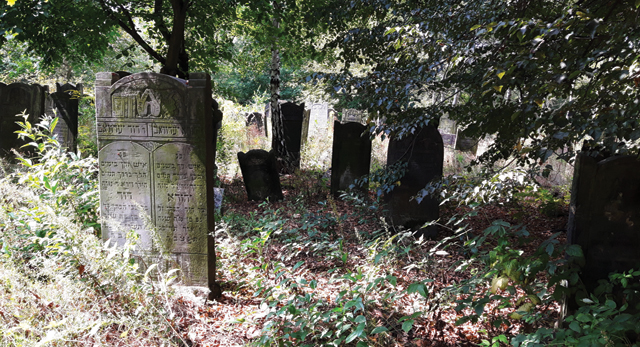STONE FOR MATZEVAH 2

Ornaments on Jewish tombstones do not serve a decorative purpose, instead they carry a symbolic meaning. Two hands joined in a gesture of blessing suggest that we are most likely standing over a rabbi’s grave, while a hand throwing coins symbolises a charitable person. There are many other symbolic motifs that provide information about the profession, personality, or origin of the deceased.
Under the ornaments there are inscriptions. Up until the 19th century epitaphs were written exclusively in Hebrew. What is noteworthy is that older matzevahs carry the first names of the deceased and the names of their fathers, but not their surnames. The date of birth is also missing. According to the Jewish calendar, only the year of death is marked on the tombstone, typically without the first digit.

In Jewish cemeteries we can often see pebbles stacked on the graves. It is a symbolic way to commemorate the dead akin to the Christian tradition of lighting candles on the graves. This custom presumably dates back to the times when people were buried in the desert and their remains were protected from wild animals by placing stones on the grave. The idea that a person’s grave cannot be touched is deeply rooted in the Jewish tradition. That means that the place where someone has been buried cannot be used as a resting place for another person, because the deceased is waiting in their grave for the Messiah’s arrival.
For this reason bodies were buried without caskets in order to allow contact of the deceased with the earth and promote decay. Only one person can lie in the grave and the body always lies with their head to the west and feet to the east.
Despite the efforts of conservationists and various foundations to preserve the Jewish cemeteries, they often look rather neglected. Many graves are in a poor condition and it seems that no one is taking care of them. This is partially because Orthodox Jews believe that once the matzevah is installed, the body of the deceased is under God’s protection and people should no longer intervene. Despite this belief, organisations and individuals strive to restore important monuments to their former glory.
If we expect others to show respect to our burial places, we should in turn respect their traditions. Food and drink are forbidden in Jewish cemeteries, and men should enter with their head covered. Furthermore, one should take a shortcut across a Jewish cemetery. If we are willing to follow these rules, we can visit the cemetery and enjoy deciphering the symbolic meaning of the ornaments and inscriptions below them.
Source: Kurier kamieniarski
Author: Jakub Zdańkowski | Published: 14 May 2019
